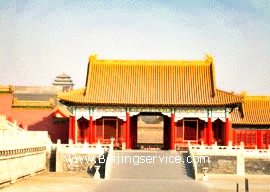Home / Beijing Tour / Beijing Private Tour / Beijing Discover / Beijing Attractions :
Gate of Supreme Harmony --Taiheme of Forbidden City
Introduction of Gate of Supreme Harmony
Introduction
Architecture
Construction
Present condition
Treasure
Forbidden City tour
more ...
The large courtyard beyond the Inner Golden Water River covers ten thousand square meters of Imperial China, the emperor was regarded as the Son of Heaven. Born to rule the empire, he has the loftiest position, and no one and nothing could appear higher. so the large courtyard is treeless. Occupying the centre of the northern side of this courtyard is Taihemen, the Gate of Supreme Harmony.
Taihemen (Gate of Supreme Harmony) is located in the north. It is guarded by two bronze lions, one on each side. Lions were supposed to be good doorkeepers because of their mighty and awesome look. They were regarded by the ancient Chinese as divine animals, capable of warding off evil spirits.
 The male lion is playing with a ball, which is said to represent the control of the whole universe by the emperor. The female lion is playing with a cub, which symbolizes prosperity of the royal family's offspring.
The male lion is playing with a ball, which is said to represent the control of the whole universe by the emperor. The female lion is playing with a cub, which symbolizes prosperity of the royal family's offspring.
History of the Gate of Supreme Harmony
The gate was burnt down in 1888, and rebuilt in the following year. During the Ming Dynasty and early Qing Dynasty, this was where the emperor held his court to handle the state affairs. The emperor would sit in the gateway, accept documents from his ministers and make the decisions.
Beyond the Gate of supreme Harmony, there is a courtyard, 10, 000 square meters (12, 000 square yards) in area. When the ceremonies were held in the Hall of Supreme Harmony, the civil and military officials stood in lines in the courtyard with the high ranking officials in the front, all dressed in their splendid ceremonial robes. A long whip cracked three times as a signal and the whole assembly in unison performed the nine prostrations.
 In the courtyard, there are big cauldrons for storing water against fire. There used to be 308 in the whole palace but now only 231 are left. They were made of iron, bronze or gilded-bronze. The iron cauldrons ere made in the Ming Dynasty the bronze ones ere made in the Ming and Qing , and the 18 gilded ones were works of the Qing Dynasty.
In the courtyard, there are big cauldrons for storing water against fire. There used to be 308 in the whole palace but now only 231 are left. They were made of iron, bronze or gilded-bronze. The iron cauldrons ere made in the Ming Dynasty the bronze ones ere made in the Ming and Qing , and the 18 gilded ones were works of the Qing Dynasty.
Though the Forbidden city was heavily guarded and surrounded by high walls with watch towers, the emperor had the foundation beneath the courtyard paved with fifteen layers of bricks in a special way: seven layers lengthwise, and eight layers crosswise, one layer lengthwise upon one layer crosswise, to prevent potential assassins from digging underground tunnels into the palace.
Great Wall tour
Beijing private tour
Xingang Beijing tour
Beijing one day tour
Beijing package tour
Beijing join in tour
![]() Beijing Tour Related
Beijing Tour Related
Beijing pictures
Beijing discover
Beijing highlights
Beijing attractions
Travel Beijing toolkits
Beijing Tour Knowledge
#.Question: Which hotel you suggest when i plan a trip to Beijing?
#.Answer:
We suggest Beijing Prime Hotel (5 star), Holiday Inn Temple
...
Travel Beijing Tookit
| Home | About us | Contact us | Link to us |
Copyright @ www.Beijingservice.com since 2003 Beijing Xindong International Travel Service

